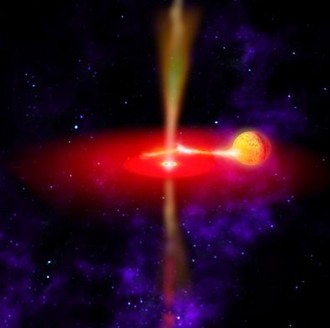
Merging compact binaries have provided the strongest motivation yet to build wide-band interferometric gravitational wave detectors. Second generation detectors, the Laser Interferometer Gravitational-wave Observatory (LIGO) in the US, Virgo in Italy and KAGRA in Japan, have the potential to observe the late inspiral of compact binaries similar to Galactic double neutron star systems (e.g., the Hulse-Taylor pulsar 1913+16). At the moment, there are no known double black hole (BH-BH) or black hole-neutron star (BH-NS) systems. High mass X-ray binaries (HMXBs) provide a unique opportunity to study various astrophysical phenomena. At Warsaw Observatory we have undertaken a program to study HMXBs in the context of the formation of double compact objects like BH-BH or BH-NS systems.
In a recent paper "Cyg X-3: a Galactic double black hole or black hole-neutron star progenitor" Krzysztof Belczyński, Tomasz Bulik from the Warsaw University Observatory and Joanna Mikołajewska, Andrzej Zdziarski from the Copernicus Center and their collaborators argue that Cyg X-3 is a very likely BH-BH or BH-NS progenitor. This Galactic X-ray binary consists of a compact object, wind-fed by a Wolf-Rayet (WR) type companion. Based on a comprehensive analysis of observational data, it was recently argued that Cyg X-3 harbors a 2-4.5 Msun BH and a 7.5-14.2 Msun WR companion. We find that the fate of such a binary leads to the prompt (<1 Myr) formation of a close BH-BH system for the high end of the allowed WR mass (M_WR>13 Msun). For the low- to mid-mass range of the WR star (M_WR=7-10 Msun) Cyg X-3 is most likely (probability 70%) disrupted when WR ends up as a supernova. However, with smaller probability, it may form a wide (15%) or a close (15%) BH-NS system. The advanced LIGO/VIRGO detection rate for mergers of BH-BH systems from the Cyg X-3 formation channel is 10 per year, while it drops down to 0.1 per year for BH-NS systems. If Cyg X-3 in fact hosts a low mass BH and massive WR star, it lends additional support for the existence of BH-BH/BH-NS systems.
The picture: NASA






